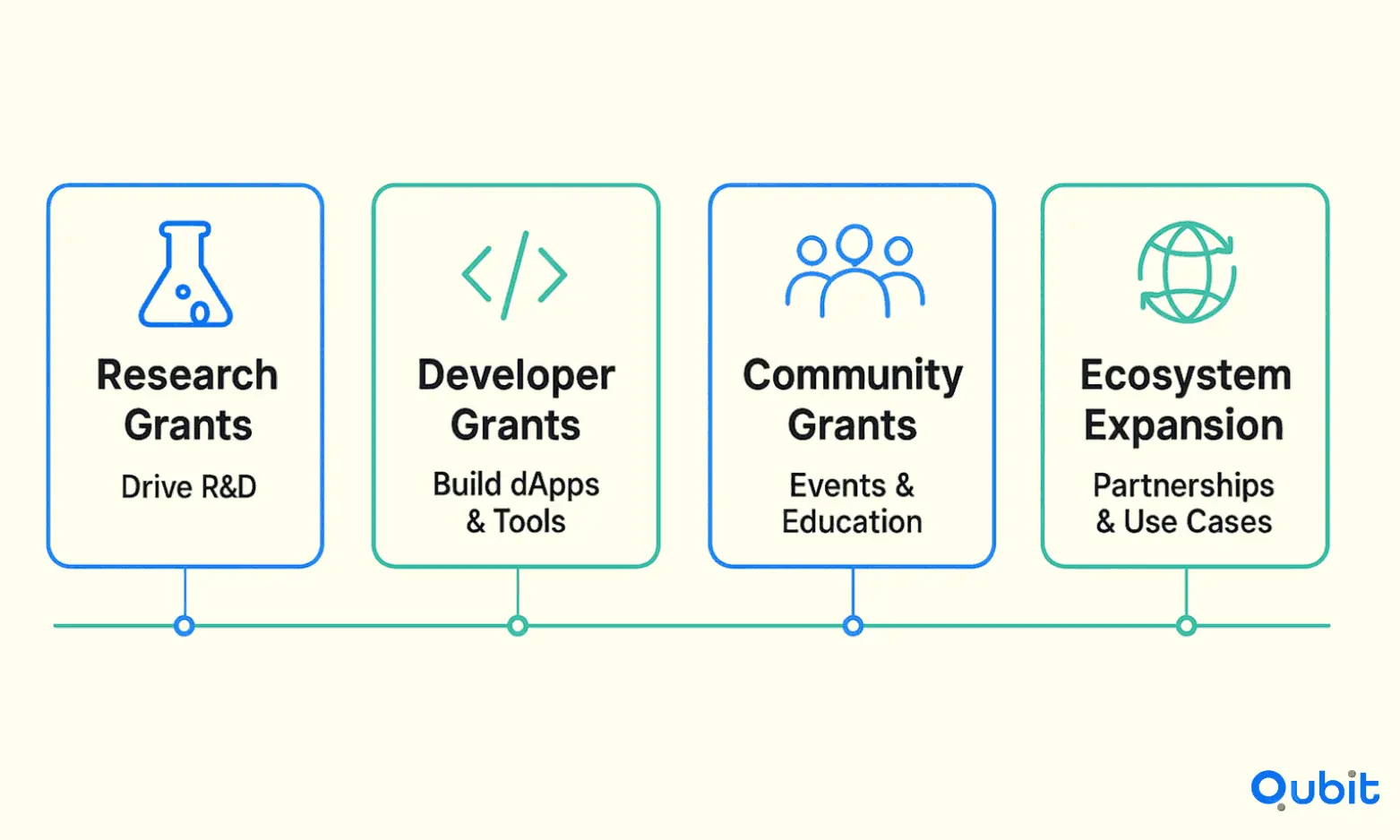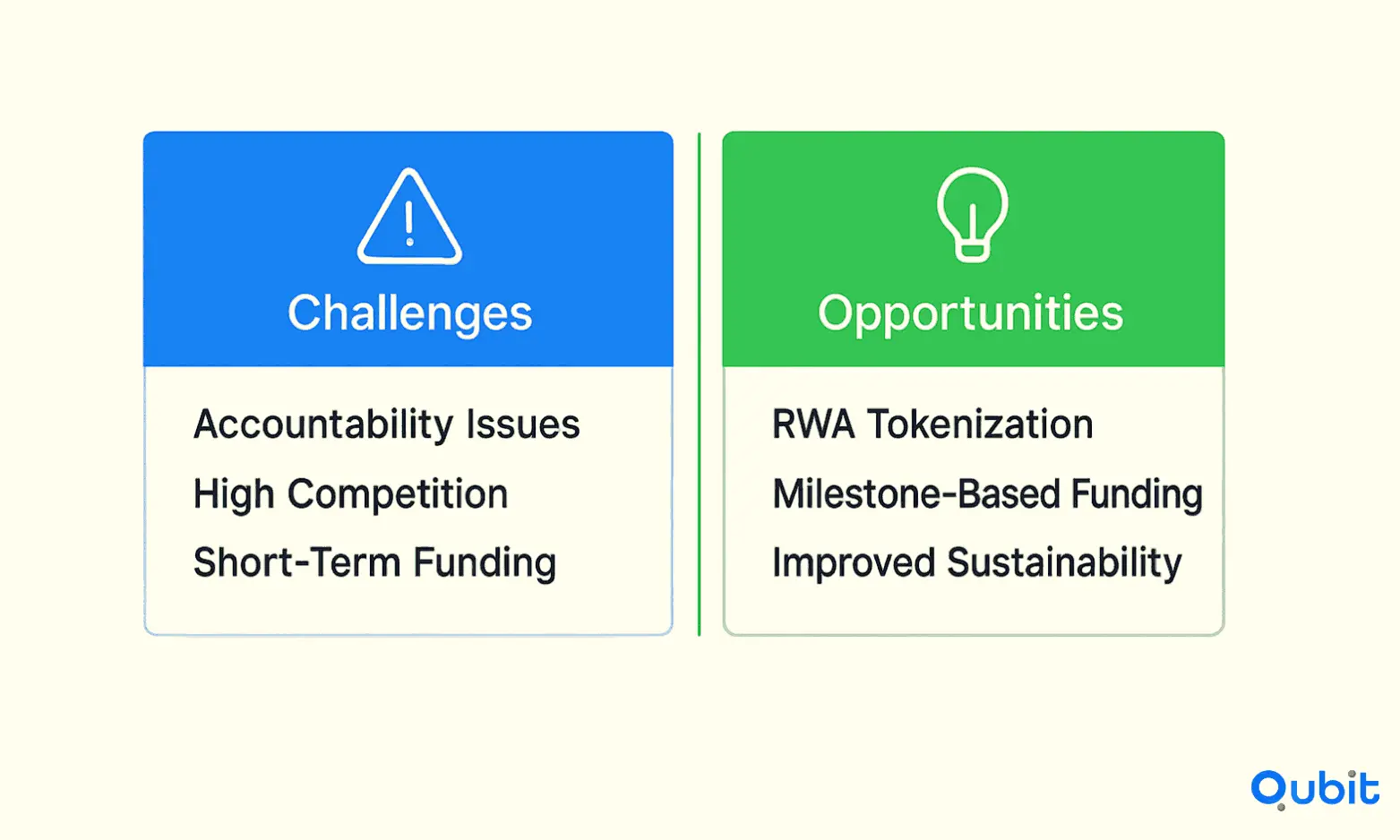Blockchain innovation thrives on collaboration, and Layer-1 protocols are leading the charge by offering grants and ecosystem funds to fuel development. These initiatives empower developers and startups to build decentralized applications, tools, and infrastructure that enhance the protocol’s ecosystem. Whether you're launching a new project or scaling an existing one, understanding how these funding mechanisms work is crucial for success.
A comprehensive overview of blockchain startup fundraising strategies illustrates the broader funding landscape, providing context that enriches your understanding of Layer-1 protocol grants. This blog dives into the mechanics of these grants, their impact on blockchain ecosystems, and actionable insights to help you secure funding. Let’s jump right in!
Trusted Partnerships in Web3
Collaborations with prominent blockchains and dapps are redefining trust in the Web3 ecosystem. By aligning with industry leaders, platforms can showcase their reliability and commitment to innovation. These partnerships not only enhance credibility but also serve as a cornerstone for securing ecosystem funds, ensuring sustainable growth.
Highlighting trusted collaborations, such as agreements with leading blockchains and decentralized applications, demonstrates the platform’s dedication to fostering a secure and transparent environment.
Strategic insights into corporate venture blockchain collaborations also play a significant role in funding. For more on this, explore our analysis on corporate venture blockchain, which highlights the importance of partnerships in broadening capital avenues.
All Grant Listings
Finding funding opportunities in the blockchain space can be a daunting task, but this section simplifies the process by offering a detailed list of blockchain-related grants. Whether you're a startup, researcher, or developer, these organized listings ensure you can quickly identify the grants most relevant to your needs.
From government-backed initiatives to private sector funding programs, the list covers a wide range of opportunities tailored to various blockchain applications. Each grant is categorized to help users focus on their specific area of interest, such as decentralized finance (DeFi), supply chain solutions, or blockchain infrastructure development.
The streamlined format not only saves time but also enhances accessibility, making it easier for users to explore funding options without sifting through endless resources. By providing concise descriptions and eligibility criteria, this section empowers innovators to take the next step in securing financial support for their blockchain projects.
Community Engagement
Building meaningful connections within the blockchain ecosystem is essential for driving innovation. Community engagement fosters collaboration among developers, enabling them to share ideas, solve challenges, and create groundbreaking solutions in the Web3 space. By joining forces, blockchain enthusiasts can amplify their impact and contribute to the evolution of decentralized technologies.
At the heart of this movement is the opportunity to become part of a growing network of innovators. Whether you're a seasoned developer or just beginning your journey, engaging with like-minded individuals can open doors to new partnerships, mentorships, and resources. Collaboration not only accelerates personal growth but also strengthens the collective efforts of the community.
Additionally, exploring decentralized funding methods can further enhance community-driven projects. Insights from the blockchain launchpad IDO guide reveal innovative approaches to fundraising that align with the ethos of collaboration and shared success.
The Web3 community thrives on active participation and mutual support. By contributing your expertise and engaging with others, you can play a pivotal role in shaping the future of blockchain technology. Join the movement today and be part of a dynamic ecosystem that values creativity, inclusivity, and progress.
Layer-1 Protocols
Layer-1 protocols form the foundation of blockchain technology, acting as the primary networks that enable decentralized applications (dApps) and smart contracts. These protocols are the structural backbone upon which the entire ecosystem of decentralized innovation is built.
By providing the essential infrastructure, Layer-1 protocols ensure the security, scalability, and functionality required for blockchain networks to thrive. Ethereum, Bitcoin, and other prominent Layer-1 networks have set the stage for groundbreaking advancements in decentralized finance, supply chain management, and digital identity verification.
What makes these protocols indispensable is their ability to maintain consensus mechanisms, such as Proof of Work (PoW) or Proof of Stake (PoS), which validate transactions and secure the network. This ensures trustless interactions between users and applications, eliminating the need for intermediaries.
As blockchain technology evolves, Layer-1 protocols continue to drive innovation by addressing challenges like transaction speed, energy efficiency, and interoperability. Their adaptability paves the way for developers to create more sophisticated dApps and smart contracts, pushing the boundaries of what decentralized systems can achieve.
Importance of Grants and Ecosystem Funds
Grants and ecosystem funds play a pivotal role in driving innovation within blockchain ecosystems. By offering financial support to developers and startups, these resources reduce the financial risks associated with building new technologies. This enables creators to focus on developing groundbreaking solutions without the immediate pressure of securing revenue streams.
Blockchain ecosystems thrive on continuous growth and experimentation, and grants act as a catalyst for this progress. For example, the $13.6 billion in venture capital funding for blockchain startups in 2024 highlights the scale of investment in the industry. While VC funding often targets later-stage projects, grants and ecosystem funds focus on nurturing early-stage ideas, ensuring that promising concepts receive the support they need to mature.
Additionally, ecosystem funds incentivize development by fostering collaboration among developers, researchers, and entrepreneurs. These funds create a supportive environment where innovation flourishes, ultimately contributing to the long-term sustainability of blockchain networks. The $3.5 billion in crypto VC investment during Q4 2024 further underscores the growing interest in early-stage blockchain projects, complementing the role of grants in driving initial development.
For developers seeking additional funding avenues, insights into blockchain venture funds provide a detailed look at options that complement Layer-1 ecosystem funding. These resources collectively ensure that blockchain ecosystems remain vibrant, adaptable, and primed for future growth.
Types of Grants Offered by Layer-1 Protocols
Layer-1 blockchain protocols provide a wide array of grants designed to address the diverse needs of the blockchain ecosystem. These grants play a pivotal role in fostering innovation and ensuring the sustainable growth of decentralized technologies.

One prominent category of grants focuses on research and development. These initiatives often fund academic studies, technical advancements, and experimental projects that aim to solve complex blockchain challenges. By supporting groundbreaking research, Layer-1 protocols encourage the creation of more secure, scalable, and efficient systems.
Another significant area is developer-focused grants, which target individuals or teams building decentralized applications (dApps), tools, or infrastructure. These grants often include financial support, mentorship, and access to technical resources, enabling developers to bring their ideas to life and contribute to the protocol’s ecosystem.
Community engagement is also a priority for many Layer-1 protocols. Community grants are designed to empower local groups, educators, and advocates who promote blockchain adoption and awareness. These initiatives often fund events, workshops, and educational content, helping to bridge the gap between blockchain technology and the broader public.
Additionally, some protocols offer ecosystem expansion grants, aimed at onboarding new users, businesses, and industries into the blockchain space. These grants often focus on partnerships, integrations, and use-case development to drive adoption across various sectors.
Examples of Layer-1 Protocols Offering Grants
Layer-1 protocols are increasingly driving innovation by offering grants tailored to their strategic goals. These initiatives are designed to foster ecosystem growth while aligning with each protocol’s long-term vision.
Ethereum Foundation Grant Program
The Ethereum Foundation exemplifies how established protocols can accelerate ecosystem development through targeted funding. In Q1 2025, the foundation distributed $32 million across 94 projects, marking a 63% increase from the previous quarter. This substantial investment highlights Ethereum’s commitment to supporting developers and projects that enhance its blockchain infrastructure. By focusing on areas such as scalability, security, and decentralized applications, Ethereum ensures that its grant program directly contributes to the protocol’s overarching goals.
Monad Labs Funding Round
Monad Labs offers another compelling example of Layer-1 development through funding initiatives. The organization raised $225 million in venture capital to build a layer-1 smart contract network. This funding round underscores the potential for Layer-1 protocols to attract large-scale investments aimed at creating robust blockchain ecosystems. Monad Labs’ approach demonstrates how strategic funding can empower developers and drive innovation within the protocol’s ecosystem.
These examples illustrate how Layer-1 protocols are shaping the blockchain landscape by customizing grant programs to align with their unique visions. Whether through direct grants or venture capital, these initiatives play a pivotal role in fostering growth and innovation across decentralized ecosystems.
How to Apply for Grants
Securing a grant begins with a clear understanding of the process and requirements. The first step is to determine your eligibility by reviewing the criteria set by the grant provider. These criteria often include factors such as organizational type, project scope, and geographic location. Ensuring you meet these requirements is essential before proceeding further.
Crafting a compelling proposal is the next critical phase. A well-structured proposal should clearly outline your objectives, the impact of your project, and how the grant funds will be utilized. Focus on presenting measurable outcomes and aligning your goals with the priorities of the grant provider. This demonstrates your commitment and increases your chances of approval.
Grant protocols often include detailed submission guidelines, which are designed to help applicants tailor their proposals effectively. Pay close attention to these instructions, as they may specify formatting, required documentation, and deadlines. Following these guidelines meticulously not only reflects professionalism but also ensures your application meets all necessary standards.
By combining a thorough understanding of eligibility criteria with a carefully crafted proposal and adherence to submission protocols, applicants can significantly improve their chances of success.
Challenges and Opportunities in Ecosystem Funding
Securing ecosystem funding often presents developers with a complex mix of hurdles and prospects. While the promise of financial backing can accelerate innovation, navigating the intricacies of funding structures and emerging trends requires strategic foresight.

Common Challenges in Ecosystem Funding
One of the primary obstacles developers face is accountability. Traditional funding models often lack mechanisms to ensure that projects meet their goals, leading to inefficiencies and stalled progress. Additionally, competition for grants and venture capital (VC) funding has intensified, making it harder for smaller teams to stand out.
Another challenge lies in aligning funding with long-term project sustainability. Many developers struggle to secure capital that supports ongoing development rather than short-term deliverables. This misalignment can hinder the growth of promising protocols and ecosystems.
Emerging Opportunities
Despite these challenges, new funding approaches are reshaping the landscape. Real-World Asset Tokenization is gaining traction, offering developers innovative pathways to connect blockchain solutions with tangible assets like real estate, commodities, and financial instruments. With VC funding for tokenization projected to grow at a 53% compound annual growth rate (CAGR) from 2025 to 2033, this trend opens doors for projects that bridge the gap between digital and physical economies.
Another promising model is Milestone-Based Grant Structures, where funding is released upon achieving predefined project milestones. This approach improves accountability and ensures that grantees remain focused on delivering results. By reducing risks for funders and encouraging ongoing development, milestone-based grants are becoming a preferred choice for ecosystem funding.
Conclusion
Understanding Layer-1 protocol grants and ecosystem funds is essential for blockchain projects aiming to secure sustainable growth. Throughout this blog, we’ve explored key strategies and insights that can help you identify and utilize these funding opportunities effectively. By aligning your project’s goals with the priorities of Layer-1 protocols, you can unlock resources that not only fuel innovation but also strengthen your position within the blockchain ecosystem.
If you’re looking to align your roadmap with protocol incentives, at Qubit we understand validator economics, grant stages, and success criteria. Strengthen your round through our fundraising assistance for blockchain startups.
Key Takeaways
- Layer-1 grants fuel innovation and bolster blockchain ecosystem growth.
- Trusted partnerships and community engagement are essential to secure funding.
- A diverse range of grants supports research, development, and community initiatives.
- Successful applications depend on clear eligibility criteria and strong proposals.
- Emerging trends like tokenization and milestone-based funding create new opportunities.
Frequently asked Questions
What are the best blockchain startup grants?
Blockchain startups can access several prominent grants designed to foster innovation and growth. Some of the top options include the Ethereum Foundation Grants, which support projects enhancing the Ethereum ecosystem, and the Solana Foundation Grants, aimed at developers building on the Solana blockchain. Additionally, the Binance Labs Incubation Program offers funding and mentorship for early-stage blockchain ventures. For further details, explore their official websites to understand eligibility and application processes.






